From Theory to Practice: How to Make a Document Smaller?
🤔Always run into delays when transferring files? Frequently run out of storage space? Get “file size exceeded” alerts when sharing documents? 😎Don’t panic — these issues often come from files being too large, so here’s a practical guide that takes you from the basics to hands-on techniques, helping you handle documents more efficiently and making file transfer, storage, and sharing smoother❕
From Theory to Practice: How to Make a Document Smaller?
Oversized documents not only take up storage space but also use much more network bandwidth, slowing down data transfer and loading speeds; this, in turn, makes it take longer to download and open documents and eventually slows down your entire workflow, which is why figuring out how to make a document smaller has become a priority. Curious to learn more? Keep reading!
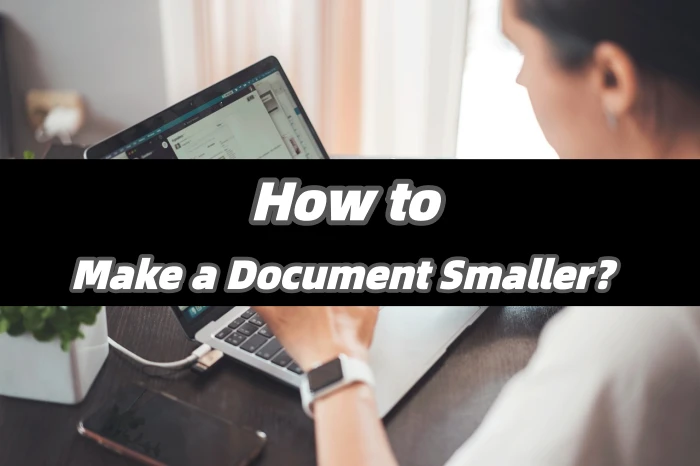
🔔 Commonly Used Document Types
| Document Category | Format Suffix | Core Purpose | Usage Scenarios |
| Text Editing | .doc/.docx | Mainstream word – processing format (Word documents), supporting complex layouts, charts, formulas, etc. | Writing project reports, business contracts, meeting minutes at work; creating essays, novels, resumes in personal life. |
| Universal Portable | Portable document format, accurately preserving original document layouts with strong cross – device and cross – software compatibility. | Receiving official documents (e.g., exam syllabi, policy notices), sharing design plans, archiving contracts and product manuals. | |
| Plain Text | .txt | Format – free text, extremely small in size, compatible with all devices and software, requiring no special opening tools. | Jotting down temporary shopping lists, storing code snippets, writing simple diaries, saving device configuration parameters. |
| Data Spreadsheet | .xls/.xlsx | Electronic spreadsheet format (Excel documents), featuring data calculation, statistical analysis, and chart generation. | Statistical sales data, financial report creation, employee attendance management at work; recording household expenses, planning travel budgets in personal life. |
| Presentation Slides | .ppt/.pptx | PPresentation document format (PowerPoint documents), supporting images, text, animations, multimedia embedding, and transition effects. | Internal company meetings for project progress updates, product demonstrations to clients, classroom lectures. |
| E-book | .epub | Mainstream e-book format, supporting adaptive layouts, adjustable font sizes, and line spacing for different reading devices. | Reading novels, textbooks, magazines on e-readers or mobile apps, organizing personal study note collections. |
💡 Key Factors Affecting Document Size
◽Text Content Volume
| The more text, numbers, and symbols a document contains, the more storage space it occupies after encoding—especially in uncompressed formats. |
◽ Image Resolution and Quantity
| Embedding high-resolution images or an excessive number of images increases a document’s size. Compressing images or reducing their quantity can effectively control document size in PPTs, PDFs, and other multimedia documents. |
◽ Font and Format Complexity
| Using special fonts, complex layouts (e.g., multi-level lists, nested tables), or embedding font files raises storage demands. Simplifying formats, standardizing fonts, or disabling font embedding reduces redundant data. |
◽ Embedded Objects and Attachments
| Embedding external objects like audio, video, and Excel spreadsheets significantly increases file size. Avoid unnecessary embeddings; instead, use hyperlinks to reference external files to optimize document storage space. |
◽ File Format and Encoding Method
| Different formats (e.g., DOCX vs. PDF) have varying compression efficiencies. Choosing efficient encoding formats (e.g., ZIP-compressed files) or adjusting compression levels can further reduce file size. |
📣 Effective Methods for Compressing Documents
◼ WorkinTool File Compressor
A lightweight and user-friendly desktop compression tool compatible with Windows and Mac systems. It supports batch compression for six major types of files including images, videos, PDFs, Word documents, PPTs and audio files, and is suitable for use in various scenarios such as education, e-commerce and graphic design.
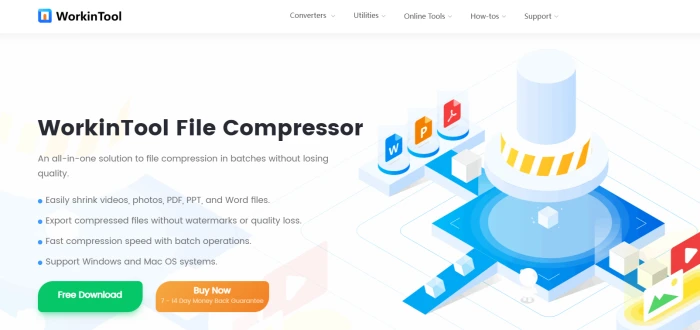
📝Specific Operation Steps:
◽1, Visit the official website via browser, download, install and open the software on your computer.
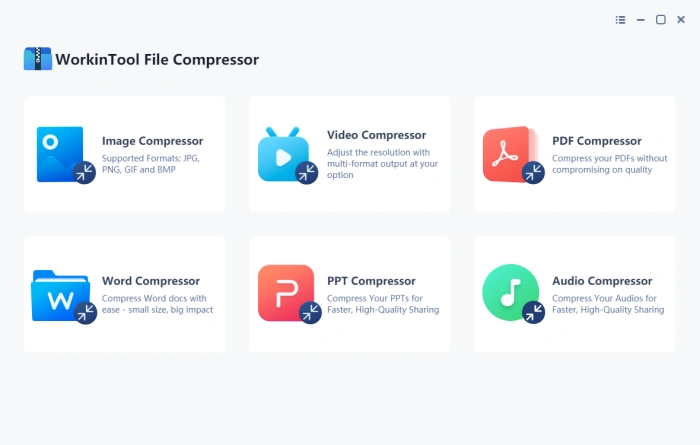
◽2, Select the relevant interface as needed, then click “Add File” to add one or multiple target files.
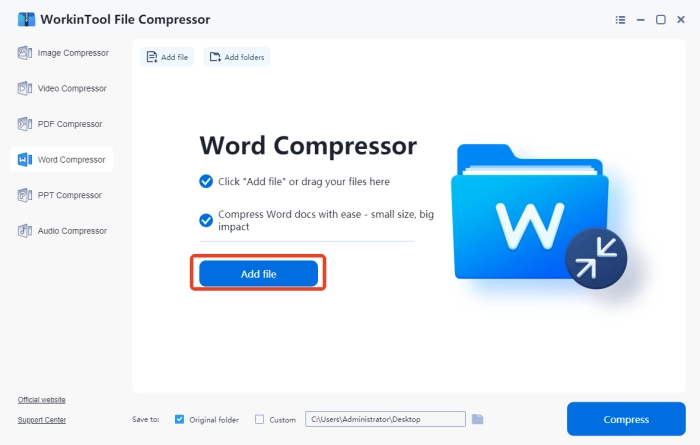
◽3, Each file’s name and original size will be shown clearly. Next, set the compression level (2–3 preset levels available).
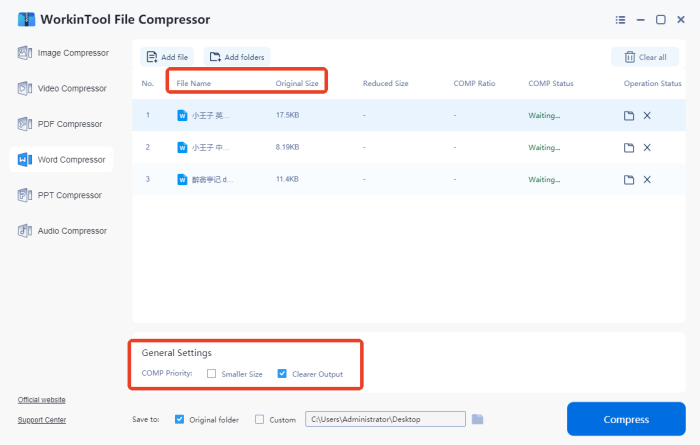
◽4, Click “Compress“; once “Success” appears, compression is done, and the compressed size and rate will be displayed directly.
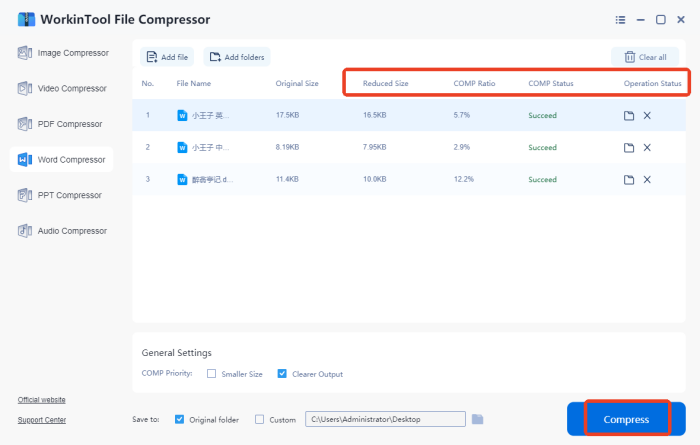
🔎 Core Values of Compressing Documents
🔹 Storage Optimization: Lossless compression technology reduces file size, directly lowering the storage space occupied on media such as hard drives and cloud storage. This saves storage costs and effectively supports the long-term archiving of large volumes of files.
🔹 Efficient Transmission: Compressed files have smaller sizes, which significantly shortens transmission time across networks and devices. It also reduces the risk of lag or interruptions caused by large file sizes, improving sharing efficiency.
🔹 Simplified Management: Packaging and compressing multiple related files simplifies subsequent classification and archiving processes. Some compression methods support security settings, which add protection when transmitting sensitive files while balancing convenience and security.
🌈 Conclusion
Making documents smaller is not only about valuing and utilizing resources efficiently, but also about enhancing and maximizing the value of information. After reading the above content, I believe you have gained a clearer and more practical understanding. Remember to put this into practice! Whether you are organizing reports, outlining ideas, writing meeting minutes, or preparing plans, stick to the principle of conciseness to ensure every document truly serves its intended purpose.


